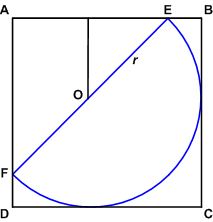Difference between revisions of "2005 AIME I Problems/Problem 11"
Dgreenb801 (talk | contribs) (→Solution) |
Dgreenb801 (talk | contribs) (→Solution 3) |
||
| Line 20: | Line 20: | ||
Our two previous paragraphs give <math>2a^2 = (16 - a)^2</math> so <math>a^2 + 32a - 256 = 0</math> and <math>a = 16\sqrt{2} - 16</math> (where we discard the negative root of that quadratic) and so <math>d = a\sqrt{2} = 32 - 16\sqrt{2} = 32 - \sqrt{512}</math>, so the answer is <math>32 + 512 = 544</math>. | Our two previous paragraphs give <math>2a^2 = (16 - a)^2</math> so <math>a^2 + 32a - 256 = 0</math> and <math>a = 16\sqrt{2} - 16</math> (where we discard the negative root of that quadratic) and so <math>d = a\sqrt{2} = 32 - 16\sqrt{2} = 32 - \sqrt{512}</math>, so the answer is <math>32 + 512 = 544</math>. | ||
| − | |||
| − | |||
== See also == | == See also == | ||
Revision as of 00:22, 2 March 2008
Problem
A semicircle with diameter ![]() is contained in a square whose sides have length 8. Given the maximum value of
is contained in a square whose sides have length 8. Given the maximum value of ![]() is
is ![]() find
find ![]()
Contents
[hide]Solution
We note that aligning the base of the semicircle with a side of the square is certainly non-optimal. If the semicircle is tangent to only one side of the square, we will have "wiggle-room" to increase its size. Once it is tangent to two adjacent sides of the square, we will maximize its size when it touches both other sides of the square. This can happen only when it is arranged so that the center of the semicircle lies on one diagonal of the square.
Now, let the square be ![]() , and let
, and let ![]() and
and ![]() be the points at which the "corners" of the semicircle touch the square. Let
be the points at which the "corners" of the semicircle touch the square. Let ![]() be the center of the semicircle.
be the center of the semicircle.
Solution 1
Define the radius of the semicircle as ![]() . Draw the perpendicular from
. Draw the perpendicular from ![]() to
to ![]() , which forms a
, which forms a ![]() triangle. The length of the perpendicular is
triangle. The length of the perpendicular is ![]() . Note also that
. Note also that ![]() is equal to the length of that perpendicular plus the radius to the point of tangency on
is equal to the length of that perpendicular plus the radius to the point of tangency on ![]() . Thus,
. Thus, ![]() , and
, and ![]() . The diameter is then
. The diameter is then ![]() , and the solution is
, and the solution is ![]() .
.
Solution 2
By the comments above, ![]() . By the Pythagorean Theorem,
. By the Pythagorean Theorem, ![]() .
.
Now, if we draw a line through the center, ![]() , of the semicircle and its point of tangency with
, of the semicircle and its point of tangency with ![]() , we see that this line is perpendicular to
, we see that this line is perpendicular to ![]() and so parallel to
and so parallel to ![]() . Thus, by triangle similarity it cuts
. Thus, by triangle similarity it cuts ![]() in half, and so by symmetry the distance from
in half, and so by symmetry the distance from ![]() to
to ![]() is
is ![]() and so the distance from
and so the distance from ![]() to
to ![]() is
is ![]() . But this latter quantity is also the radius of the semicircle, so
. But this latter quantity is also the radius of the semicircle, so ![]() .
.
Our two previous paragraphs give ![]() so
so ![]() and
and ![]() (where we discard the negative root of that quadratic) and so
(where we discard the negative root of that quadratic) and so ![]() , so the answer is
, so the answer is ![]() .
.
See also
| 2005 AIME I (Problems • Answer Key • Resources) | ||
| Preceded by Problem 10 |
Followed by Problem 12 | |
| 1 • 2 • 3 • 4 • 5 • 6 • 7 • 8 • 9 • 10 • 11 • 12 • 13 • 14 • 15 | ||
| All AIME Problems and Solutions | ||










